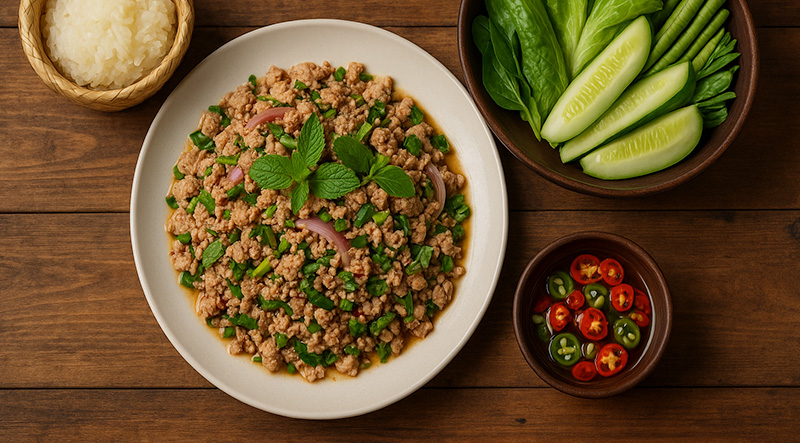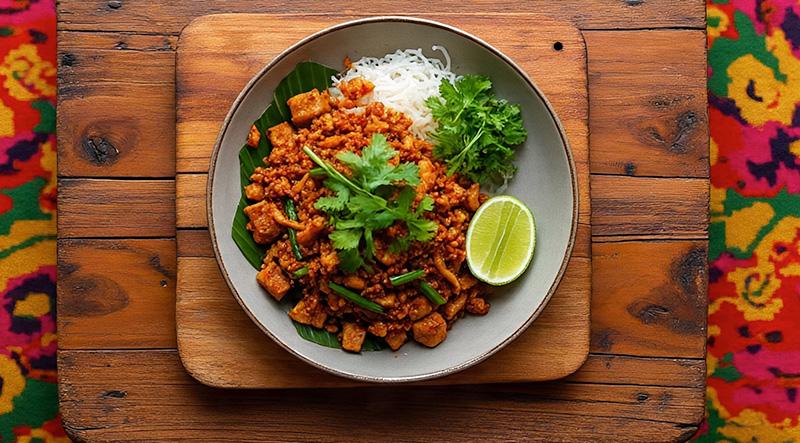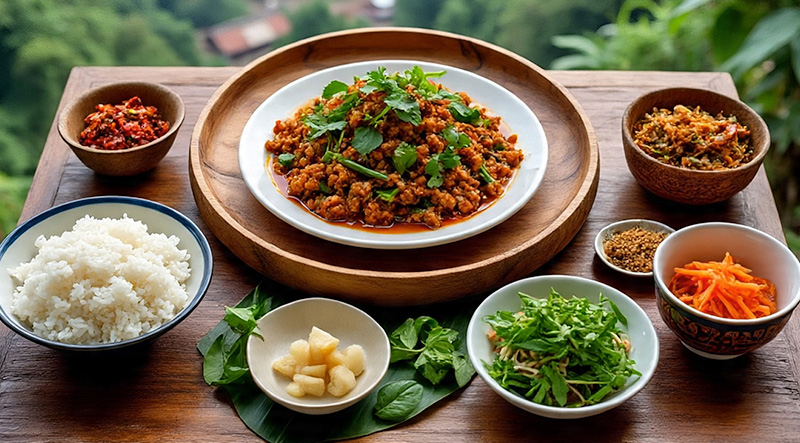The essence of Laotian cuisine is **Larb**, which is fresh, fiery, and bursting with bold flavor. Usually made with chicken, pork, beef, or fish, this zesty minced meat salad is tossed with fish sauce, lime juice, chili, fresh herbs, and toasted ground rice for a distinctive nutty crunch. Larb is the ideal balance of savory, sour, salty, and spicy flavors, and it's served with sticky rice and crunchy vegetables. Vibrant, fragrant, and unforgettable, this Laotian national dish is a feast for the senses, whether it is consumed at festive events or during casual family meals. Read More...
The History of Larb – Laos’ National Dish of Flavor and Tradition:
In the lush, river-fed landscapes of Southeast Asia, one dish has risen above all others to become the crown jewel of Laotian cuisine: Larb (also spelled Laap, Laab, or Larp). Celebrated for its bold, refreshing flavors and cultural depth, Larb is more than just a meal—it’s a proud expression of Lao identity, heritage, and hospitality.
What is Larb?
At its core, Larb is a minced meat salad, made from finely chopped chicken, pork, beef, duck, or fish, seasoned with a punchy mix of lime juice, fish sauce, fresh herbs like mint and cilantro, ground toasted rice, shallots, and chili. It’s traditionally served at room temperature, alongside sticky rice (khao niao) and a selection of raw or blanched vegetables such as cabbage, green beans, or cucumber.
But Larb is more than a flavor bomb—it’s a dish of balance. Its signature comes from the interplay between sour (lime), salty (fish sauce), spicy (chili), and aromatic (herbs) components, with toasted rice powder adding a unique earthy texture.
Roots in Ancient Traditions:
The origins of Larb date back centuries and are deeply connected to the agricultural and animist traditions of the Lao people. The dish is believed to have originated in the northern regions of Laos, where it was often used in rituals and family gatherings as a symbol of prosperity, good luck, and respect.
In Lao culture, meat was reserved for special occasions, so dishes like Larb were typically served during celebrations, weddings, harvest feasts, or Boun (religious festivals). It was not only a means of nourishment but also a way to honor ancestors, welcome guests, and mark important life events.
The word Larb itself is derived from a Lao term meaning “to win, luck, or good fortune,” reinforcing its role as a dish tied to prosperity and positivity.
A Regional Favorite:
While Larb is proudly Laotian, its influence extends across borders—particularly into Thailand, where it is also beloved, especially in the Isan region (northeastern Thailand), an area with strong cultural and ethnic Lao ties. In Thai cuisine, Larb often includes sugar, additional chilies, or even variations using raw meat or offal. Yet, traditional Lao Larb typically avoids sweetness and focuses more on herbal brightness and savory depth.
Larb also shares traits with other Southeast Asian dishes like nam tok (meat “waterfall” salad) or even Vietnamese minced meat salads, but it remains distinct due to the use of toasted rice powder, which gives it an unmistakable texture and flavor.
Modern-Day Larb: From Street Food to Fine Dining:
In modern Laos, Larb is both everyday comfort food and a national culinary emblem. It’s served everywhere—from humble homes and street stalls to elegant restaurants and cultural festivals. As Laos opens up to tourism and global food culture, Larb has become one of the country’s most recognizable and exportable dishes.
Internationally, chefs have embraced Larb for its versatility. It can be made with nearly any protein, including tofu or mushrooms for vegetarian versions, and it adapts well to modern diets and presentation styles while staying true to its roots.
A Dish of Unity and Identity:
Larb is a dish that captures the spirit of Laos in every bite. With its mix of fresh ingredients, bold flavors, and centuries-old traditions, it’s a culinary expression of what it means to be Lao—resilient, generous, and deeply connected to the land and community.
Whether enjoyed at a family gathering in Vientiane or in a bustling restaurant abroad, Larb continues to represent not just a nation’s flavor profile, but also its soul.
Make Toasted Rice Powder (Khao Khua):

Cook the Meat:
Build the Larb:

Taste and Adjust:
Serve:

Tips & Variations:
Larb takes about 30 minutes to prepare and cook in total. It takes roughly 15 to 20 minutes to prepare the ingredients, which include chopping herbs, slicing shallots, grinding toasted rice powder, and combining the sauce. This is especially true if you're making your own toasted rice powder. The meat only needs to be cooked for 5 to 10 minutes over medium heat to be thoroughly cooked but still moist. It just takes a few minutes to combine everything once the meat has cooled a little. Larb is a quick and tasty dish that is ideal for a satisfying, fresh meal because it is usually served warm or at room temperature.
According to the recipe, a single serving of larb has between 250 and 350 calories, depending on the meat and other ingredients. While fattier meats like beef or duck may slightly increase the calorie count, lean ground chicken or pork keeps it lower (between 200 and 250). Fish sauce, lime juice, fresh herbs, and toasted rice powder add a lot of flavor with very few calories. Depending on the portion, serving Larb with lettuce wraps or sticky rice adds an additional 100–150 calories. All things considered, larb is a flavorful, fresh, and comparatively light dish that is high in protein.







